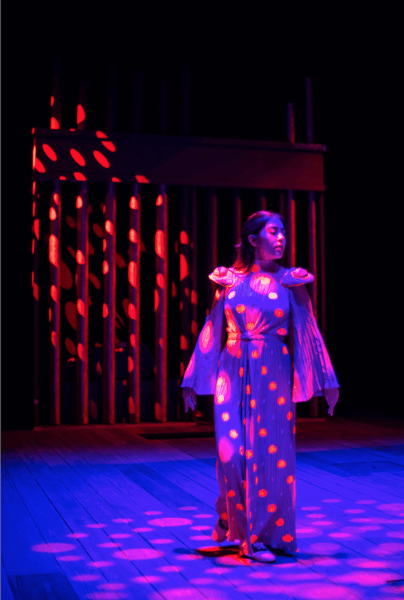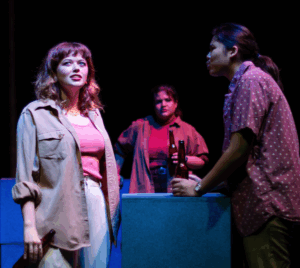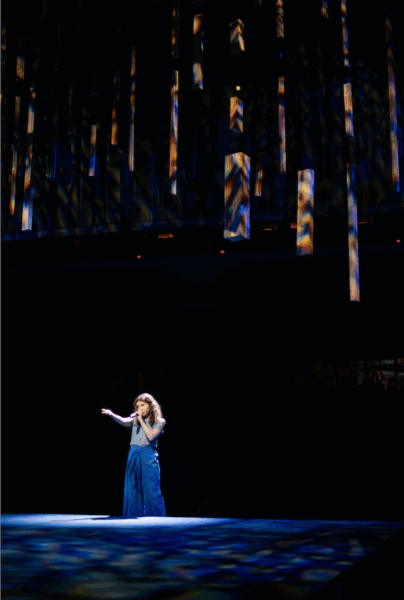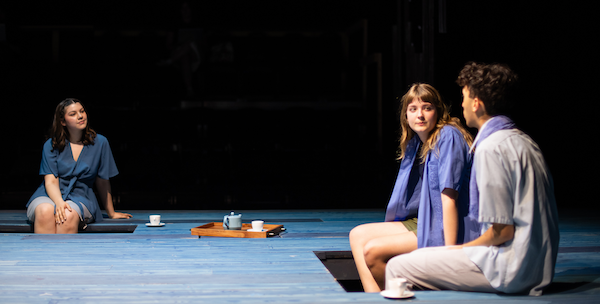Photos by B App
A remarkable production of an unconventional play opened onstage (literally) at Cal Poly’s Spanos Theatre on May 8.
 Passage—written by award-winning playwright Christopher Chen, directed by freelance stage director and Atascadero native Claire Edmonds, and presented by the Cal Poly Theatre & Dance Department—is equal parts thought-provoking, peculiar, and strangely familiar.
Passage—written by award-winning playwright Christopher Chen, directed by freelance stage director and Atascadero native Claire Edmonds, and presented by the Cal Poly Theatre & Dance Department—is equal parts thought-provoking, peculiar, and strangely familiar.
Chen’s plays are known for exploring the hidden patterns underneath complex systems, often in strange ways, and Passage is no exception. Edmonds and her cast of exceptional actors confront the challenge of the play’s dialogue and ambiguities with a fierceness that initially provokes the audience to wonder at the abstract nature of political and social power.
The cast includes Jenna Brock, Alex Campbell, Isaiah Covarrubias, Christianna Gatti, Alexander Hayward, Linnaea Marks, Rosibel Mendez, Lauren Perales, and Julianna Valencia. On opening night, Andrea Casey played the role assigned to Alexander Hayward.
 In this kind of play, where little is prescribed by the playwright except the basic outline and dialogue, the choices made by the director and technical crew are vital to the audience’s decision whether to accept the invitation to explore this particular work of art—whether to hang around and see what develops—or to tune out.
In this kind of play, where little is prescribed by the playwright except the basic outline and dialogue, the choices made by the director and technical crew are vital to the audience’s decision whether to accept the invitation to explore this particular work of art—whether to hang around and see what develops—or to tune out.
As this production unfolds, we gradually begin to understand and go with the flow of its generic names (of both individual characters and countries). We are clearly and inevitably invited to make comparisons to current events, as well as to fictional events that take place in E.M. Forster’s A Passage to India, which Chen mines to peculiar effect in order to drive the action, and the ensuing conversation, forward.
 Some ingenious business often accompanies the push-pull of the dialogue between characters, such as an actor letting sand fall from his hands as he walks a circle on the bare stage. Characters sometimes address the audience directly, asking rhetorical questions but seeming to need audience approval or buy-in to their declarations. Settings are reinvented by the actors manipulating wooden blocks that they lift out of the stage floor, returning them when the scene is over.
Some ingenious business often accompanies the push-pull of the dialogue between characters, such as an actor letting sand fall from his hands as he walks a circle on the bare stage. Characters sometimes address the audience directly, asking rhetorical questions but seeming to need audience approval or buy-in to their declarations. Settings are reinvented by the actors manipulating wooden blocks that they lift out of the stage floor, returning them when the scene is over.
The scenic design, by Claire Lawson and Brian Healy, is rich but spare, and splendidly enhanced by the lighting design of Cosmo White and Cydney Thornton throughout the production. The cave sequence (as ambiguous and intriguing as in Forster’s tale) is particularly effective.
The costumes designed by Kasey Knapp provide a familiar, everyday ambiance to the back-and-forth between the majority of the characters (who are only identified by letters of the alphabet, not names). That is, until the characters Mosquito and Gecko show up, who in their tailored and distinctive finery add a surprising and fantastical quality to the proceedings.
The sound design by Hannah Jackson—sometimes evocative of rain and other times simply of the movement of air—is sensual, sometimes frightening, sometimes comfortingly familiar. The music (original compositions are credited to Niah Pratt) is fresh and engaging, integral to setting the mood, but not overpowering in its steady, percussive quality.
 The characters in Passage, universally fervent but often individually unyielding in their opinions, reflect the modern world of people and nations trying to control and exploit other people and countries.
The characters in Passage, universally fervent but often individually unyielding in their opinions, reflect the modern world of people and nations trying to control and exploit other people and countries.
Edmonds embraces but does not condone this worldview, referencing in her director’s notes the “colonial power structure” of daily life. Her statement is a universal and compelling argument for all artistic expression: “We have the privilege tonight of sharing this beautiful theater and confronting these realities through art, rather than through the devastation that so many are facing in their real lives in this very moment.”
That message, and the excellence of its presentation, makes the strongest case for taking a seat in Spanos Theatre to see this production.
The two-act play, which runs approximately an hour and 45 minutes including intermission, runs through May 17.
